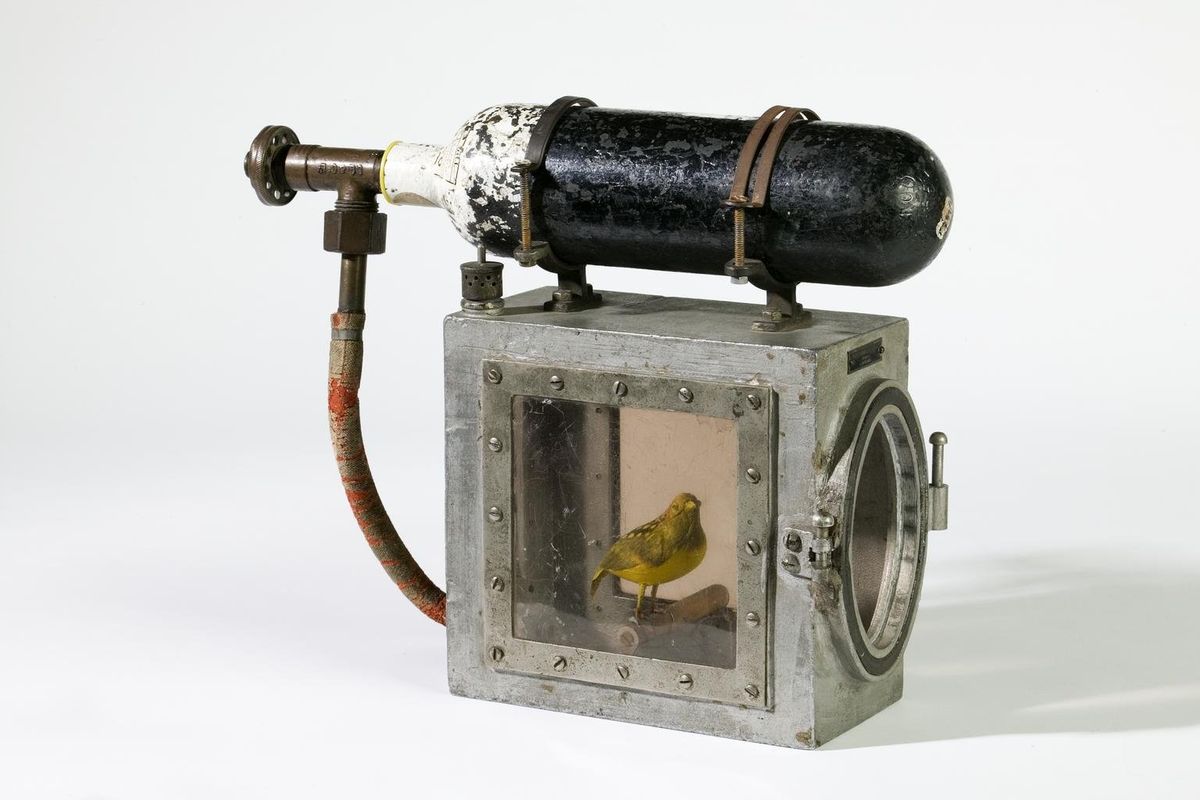The heartwarming 'canary in the coal mine' historical detail most of us didn't know
They had a canary resuscitator?!?

Cage for reviving canary, with oxygen cylinder, made by Siebe Gorman & Co. Ltd, London.
These days the phrase "canary in the coal mine" is used to refer to any early warning sign of trouble or danger, but it's based in the real history of canaries being used in coal mining. Miners would carry the songbirds into the mine with them as a makeshift carbon monoxide alarm, as the bird's small body would be impacted by the odorless gas first, giving miners time to evacuate before it built to deadly levels.
Many if not most of us probably assume the canaries used for this purpose gave up their lives to save the coal miners. As it turns out, that was not always the case.
In fact, the man who created the canary in the coal mine system went out of his way to make sure the birds could do their job safely.
After a deadly explosion in a Welsh mine in 1896, Scottish physiologist and leading expert of respiration John Haldane was asked to investigate to find the cause. He concluded that a buildup of carbon monoxide was to blame and suggested using birds or mice—animals that would be impacted by the gas far quicker than humans—to serve as sentinel species inside the mine. Because they are more sensitive to the toxins, they'd get sick (or die) before the gas reached levels that would harm or kill humans.
Canaries were determined to be ideal for this purpose because they use an immense amount of oxygen in addition to being small and portable. Their breathing habits allow toxins in the air to circulate through their bodies more quickly, giving a very early warning for carbon monoxide gas.
But rather than carry the canary into the mine in a normal birdcage as a potential sacrifice for the greater good, Haldane created a specialized cage that would allow them to live.
The "canary resuscitator" cage held the bird in a clear enclosure with a circular door that was kept open to allow air to enter through a grill that the bird from escaping. As soon as the bird showed signs of gas poisoning—swaying on its perch or collapsing—the door would be closed and a valve connected to a small oxygen tank on top of the cage would be opened. The bird would then get fresh air and the effects of the toxic gas would be reversed.

The "canary resuscitator" protected the canaries from getting too much poisonous gas.
The Board of Trustees of the Science Museum
Lewis Pollard, who served as an assistant curator at the Science and Industry Museum in Manchester, U.K., shared that the canary resuscitator was his favorite out of the museums more than 20,000 objects in 2018. "While I don’t advocate the use of animals in testing dangerous conditions, I am pleased that Haldane spared a thought for the canaries themselves and worked to make their job as non-lethal as possible," he wrote. "My impression from hearing about canaries in coal mines was that they were expected to die to warn people, so when I came across this object it was a huge relief."
There were "less thoughtful" cages used as well, Pollard added, but Haldane wasn't the only person wanting to prevent the birds' demise.
"I’ve even read that many miners cared deeply for their canary companions, and some disliked the advent of electronic sensors in the mid-1980s because it meant they would lose this companionship," wrote Pollard.
Clearly, it's better not to use animals to check for poisons when there are other options, but when the canary in the coal mine was the most viable way to prevent tragic mining accidents, it's nice to know it was done as ethically as possible.





 Patagona has always done a great job taking care of its employeesYukiko Matsuoka/Flickr
Patagona has always done a great job taking care of its employeesYukiko Matsuoka/Flickr While nursing my baby during a morning meeting the other day after a…
While nursing my baby during a morning meeting the other day after a… Not sure if Dwight Schrute would be as accomodating.
Not sure if Dwight Schrute would be as accomodating. This is a teacher who cares.
This is a teacher who cares.  Halloween costume, check.
Halloween costume, check.  "The conditions had turned WHAT?"
"The conditions had turned WHAT?" John Calhoun poses with his rodents inside the mouse utopia.Yoichi R Okamoto, Public Domain
John Calhoun poses with his rodents inside the mouse utopia.Yoichi R Okamoto, Public Domain Alpha male mice, anyone?
Photo by
Alpha male mice, anyone?
Photo by